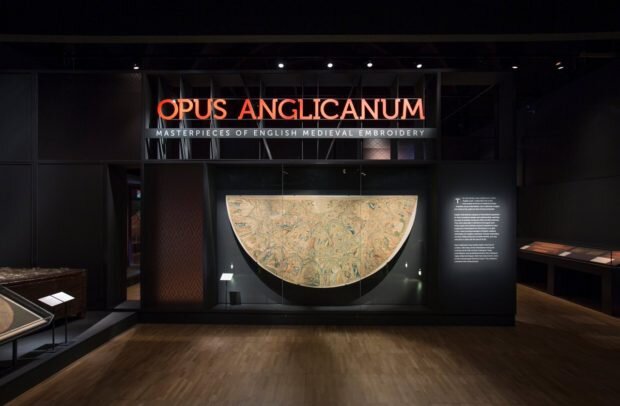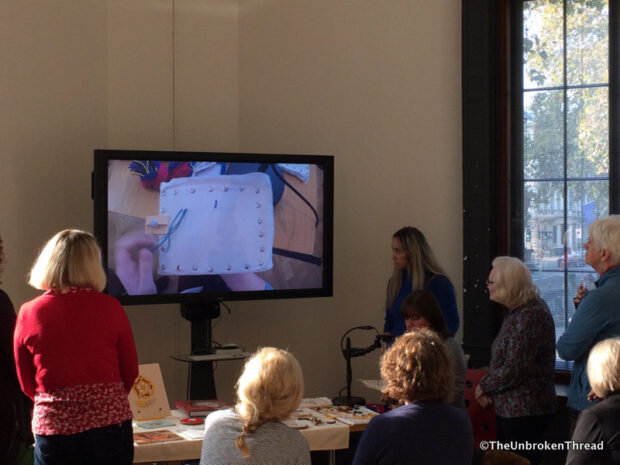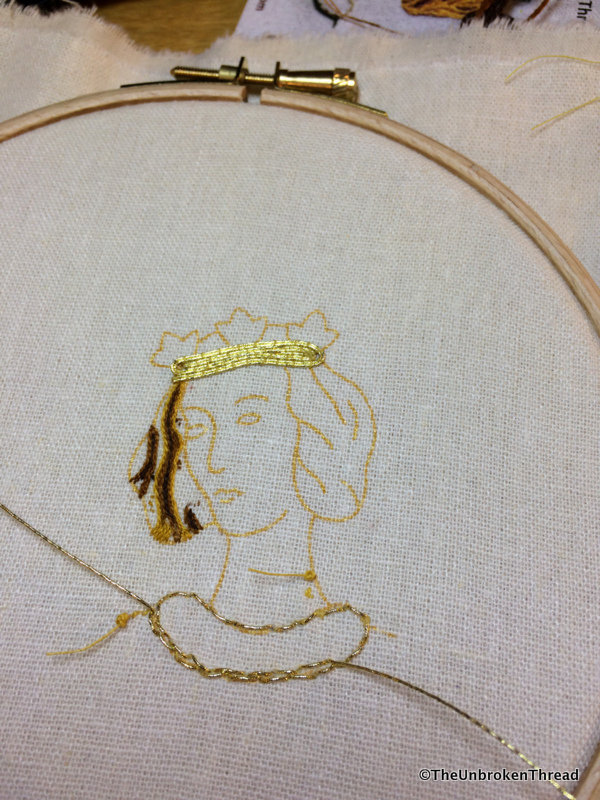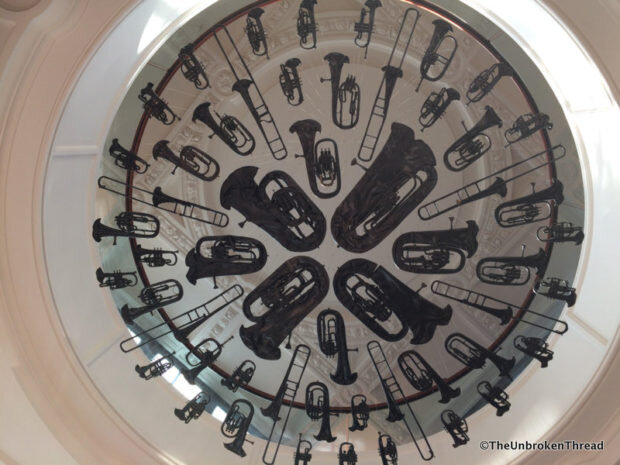Opus Anglicanum Weekend - Part 1!
I've just come home from two days in London focused entirely on embroidery. Not just any embroidery, but a once in a lifetime exhibition on Opus Anglicanum! Friday I flew into London very early and caught the Underground to South Kensington where both my hotel and the V&A Museum are located. After dropping my overnight bag at the hotel, I walked up Cromwell Road to the V&A under bright, blue skies - what a treat! Once I was inside, it took only a few minutes to walk up a short flight of stairs to the Clore Study Room in the Learning Centre, where the workshop was held. The talented and delightful Sarah Homfray was our teacher for "Opus Anglicanum: Introduction to Silk and Gold".We came in to find a large table set up for us, with a kit hoop and lamp at each place. At the front of the room was something I'd never seen before in an embroidery class - a large screen upon which the live image of the embroidery frame on the table directly underneath was being projected for all students to easily and clearly see.
Friday I flew into London very early and caught the Underground to South Kensington where both my hotel and the V&A Museum are located. After dropping my overnight bag at the hotel, I walked up Cromwell Road to the V&A under bright, blue skies - what a treat! Once I was inside, it took only a few minutes to walk up a short flight of stairs to the Clore Study Room in the Learning Centre, where the workshop was held. The talented and delightful Sarah Homfray was our teacher for "Opus Anglicanum: Introduction to Silk and Gold".We came in to find a large table set up for us, with a kit hoop and lamp at each place. At the front of the room was something I'd never seen before in an embroidery class - a large screen upon which the live image of the embroidery frame on the table directly underneath was being projected for all students to easily and clearly see. What a brilliant way to teach embroidery to a large group of 20 students! We could sit in our chairs and watch or gather around Sarah and still see in detail what she was doing.We began the morning with a short introduction and brief history of Opus Anglicanum, which was really interesting. Then we moved into our practical work. We spent the rest of the morning learning how to use split stitch to create the fine details of the face and hair that make Opus Anglicanum so exquisite. Many tiny, tiny stitches. We all wondered how in the world the embroiderers in 1260 had, 1. the eyesight to see these tiny stitch and, 2. the needles fine enough to create them!The image below is the project on which we learned the techniques and it is small - only 6.5 cm or 2 1/2 inches tall. The hair is done with a single strand of thread in split stitches. I stitched pretty much all the time we had and that's as far as I got!
What a brilliant way to teach embroidery to a large group of 20 students! We could sit in our chairs and watch or gather around Sarah and still see in detail what she was doing.We began the morning with a short introduction and brief history of Opus Anglicanum, which was really interesting. Then we moved into our practical work. We spent the rest of the morning learning how to use split stitch to create the fine details of the face and hair that make Opus Anglicanum so exquisite. Many tiny, tiny stitches. We all wondered how in the world the embroiderers in 1260 had, 1. the eyesight to see these tiny stitch and, 2. the needles fine enough to create them!The image below is the project on which we learned the techniques and it is small - only 6.5 cm or 2 1/2 inches tall. The hair is done with a single strand of thread in split stitches. I stitched pretty much all the time we had and that's as far as I got! The afternoon was focused on the two different goldwork techniques used predominately in Opus Anglicanum; surface couching and underside couching. Surface couching wasn't new for me but the underside couching was a new technique and the technique I'd come to learn.The gold thread is laid on the top side of the fabric. The needle is threaded with a linen thread (stronger than silk or even today's cotton/poly according to Sarah, who tested many threads to see what would work best). The working thread is then brought up from the back through a 'hole' in the linen created by the weave, over the gold thread and back down through the same hole in the fabric. The working thread then is pulled firmly so a small bit of the gold thread is pulled through to the back of the fabric.The working thread is visible only from the backside of the fabric, never on the front. Since all the stitches are on the backside of the fabric and covered with a lining, the gold thread is more secure. The points where the couching thread pulls the gold thread to the back side of the fabric create a pattern in the gold thread visible from the top. This pattern also serves to add flexibility to the goldwork, making it possible for the large copes to be worn more comfortably, since they can drape more easily.Sarah told us that, after she had done some underside couching with gold thread, she had a far better understanding of the work involved in creating some of the magnificent pieces in the exhibition. The gold thread we used wasn't real gold (cost considerations!) and was thicker than what was used for Opus Anglicanum. When I went to look at the exhibition, I was stunned at the amount of work I saw. Having learned the technique first, I had a much deeper understanding of what I was seeing.Something completely unrelated to the workshop or the exhibition was the opportunity to see this amazing piece of sculpture which was above our heads in the classroom.
The afternoon was focused on the two different goldwork techniques used predominately in Opus Anglicanum; surface couching and underside couching. Surface couching wasn't new for me but the underside couching was a new technique and the technique I'd come to learn.The gold thread is laid on the top side of the fabric. The needle is threaded with a linen thread (stronger than silk or even today's cotton/poly according to Sarah, who tested many threads to see what would work best). The working thread is then brought up from the back through a 'hole' in the linen created by the weave, over the gold thread and back down through the same hole in the fabric. The working thread then is pulled firmly so a small bit of the gold thread is pulled through to the back of the fabric.The working thread is visible only from the backside of the fabric, never on the front. Since all the stitches are on the backside of the fabric and covered with a lining, the gold thread is more secure. The points where the couching thread pulls the gold thread to the back side of the fabric create a pattern in the gold thread visible from the top. This pattern also serves to add flexibility to the goldwork, making it possible for the large copes to be worn more comfortably, since they can drape more easily.Sarah told us that, after she had done some underside couching with gold thread, she had a far better understanding of the work involved in creating some of the magnificent pieces in the exhibition. The gold thread we used wasn't real gold (cost considerations!) and was thicker than what was used for Opus Anglicanum. When I went to look at the exhibition, I was stunned at the amount of work I saw. Having learned the technique first, I had a much deeper understanding of what I was seeing.Something completely unrelated to the workshop or the exhibition was the opportunity to see this amazing piece of sculpture which was above our heads in the classroom. At the end of the day I was tired and, after a nice cup of tea and a scone with one of the other lovely students in the class, I went to see the exhibition for a short time (we were given tickets to the exhibition as part of the class - what a nice surprise!) and then back to my hotel.Next time - the exhibition and the lecture.
At the end of the day I was tired and, after a nice cup of tea and a scone with one of the other lovely students in the class, I went to see the exhibition for a short time (we were given tickets to the exhibition as part of the class - what a nice surprise!) and then back to my hotel.Next time - the exhibition and the lecture.
